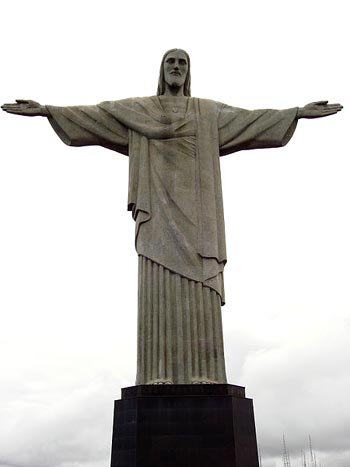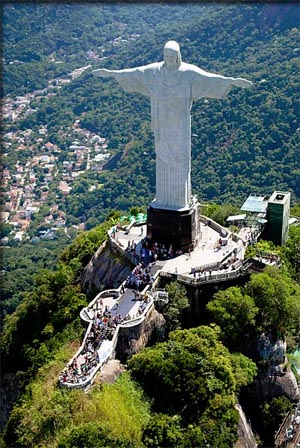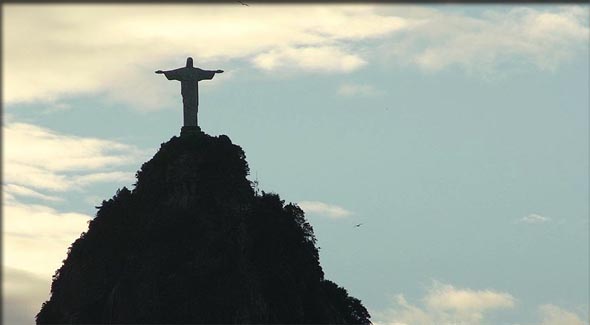A Wonder
of the World: The Christ the Redeemer Statue
|

(Photo
by Jorge Lascar licenced through CC-BY-2.0)
|
Standing
over 200 feet high on a 2,300 foot high mountain, this colossal
depiction of Jesus has become a famous symbol of the metropolis
of Rio de Janeiro, Brazil, and a new wonder of the world.
Following
the end of World War I, many members of the primarily Roman
Catholic community in Brazil were concerned about what they
felt was a growing "godlessness" around them. Some of this was
the result of the country becoming a republic in 1893 causing
the official separation of the church from the state. Members
of Catholic community felt that they could reclaim the country
for Christianity by constructing a prominent symbol in Rio,
which was then the capital city. One idea was to build a huge
statue of Christ. This proposal had been around since the 1850's
when it had been suggested by the Vincentian priest, Pedro Maria
Boss, but not much had been done about it.
Initially,
it was proposed that a bronze statue of Christ would be built
on the Sugar Loaf (a giant, steep, mound of rock at the entrance
to Rio's Guanabara Bay). However, it was decided that the peak
of Mount Corcovado, which was higher and overlooked the city,
would be a better location.
Da
Silva Costa Joins the Project
The
Catholic Circle of Rio started raising money for the project
in 1920 and Da Silva Costa, a local engineer, was chosen to
design it. Costa went through several drawings before deciding
on the one that was eventually used. One of his earliest sketches
was of Christ carrying a cross and holding a globe in his outstretched
hand. This particular drawing was ridiculed by some as "Christ
with a ball" design. Working with artist Carlos Oswald, Da Silva
finally developed the design we see today with Christ with his
arms open wide, both forming a cross with his body, and at the
same time seeming to welcome those who would come to him.
|
Seven
Quick Facts
|
| Location:
Mount Corcovado, 2300 feet (700m) above Rio de Janeiro,
Brazil. |
| Construction:
Started in 1922 and finished in 1931. |
| Height:
98 feet (30m) without pedestal and 125 feet (38m) including
the pedestal. |
| Weight:
635 metric tons. |
| Made
of: Steel reinforced concrete covered with soapstone
tiles. |
| Designers:
Engineer Da Silva Costa with sculptors Paul Landowski
and Gheorghe Leonida. |
| Other:
Cost is equivalent of US $250,000 (which is $3,400,000
in 2016 dollars). |
While
the design seemed to be just what was desired, to actually construct
a colossal statue with outstretched, unsupported arms was a
difficult engineering problem. Costa finally settled on using
steel reinforced concrete, a new building material at the time,
to construct the edifice. Costa went to France to seek the council
of Albert Caquot, an expert in concrete. While there he spoke
to a number of artists and finally settled upon sculptor Paul
Landowski to create the artistic part of the work. Landowski,
in turn, commissioned sculptor Gheorghe Leonida to create the
face. They decided to do the statue in the art deco style, which
was popular at the time.
While
concrete solved the structural problems, Costa felt it was too
rough a material for the surface of the statue. Taking inspiration
from a newly-constructed fountain he'd seen in an arcade on
the Champs Elysees, he realized that small tiles would allow
him the to cover the curving surface of the statue in a smooth
material. As far as Costa was aware, this was the first time
tiling would be used to cover a statue. It took 6 million of
the triangular 1 ¼ inches by 1 ¼ inches(3cm) tiles to cover
the colossus.
A
Soapstone Surface
Costa
chose soapstone because he had seen it used in sculptures by
18th Century Brazilian sculptor Aleijadinho. Costa had observed
that Aleijadinho's works showed little sign of wear even after
120 years, proving that the material was extremely durable.
|

An
aerial view of the statue and surrounding platforms.(Photo
by Gustavo Facci licenced through CC-BY-2.0)
|
The
actual construction of the statue started in 1922 and lasted
seven years. The statue was opened to the public on October
12, 1931, and cost the equivalent of US $250,000 (which is $3,400,000
in 2016 dollars). It stands 98 feet tall (30m) without its pedestal
and 125 feet (38m) with it. The figure's arms span a total length
of 92 feet (28m). Costa made sure that it was big enough to
be easily seen from the city below.
Lightning
Strikes
Maintaining
such a large, concrete statute in the tropical climate of Rio
has its challenges. Mt. Mount Corcovado's tropical location
makes it a natural target for heavy storms, strong winds and
lightning strikes. The statue is usually hit by lightning from
two to four times a year. A set of lightning rods is built into
the structure of the statue, but getting them properly grounded
at the top of the mountain is a problem. The granite of the
peak is not naturally very conductive. While most lightning
strikes do no damage, two in January of 2014 scorched the back
of the head and blasted the fingertip off the middle finger
of one hand. Authorities had to act quickly to get the colossal
statue back in shape before the capital swelled with visitors
for the World Cup in June of that year.
Workers
can enter the statue via a door in the hem of the robe, just
behind where the right ankle would be. From there, they can
climb stairs up the interior the equivalent of 12 stories to
the chest where they can cross into narrow tunnels that extend
out the arms or up through a trap door on the right shoulder.
From hidden exits like these, they can repel like mountain climbers
down the outside of the statue to repair damaged sections.
Not
all attacks on the statue have been from nature, however. In
2010 during a restoration, a pair of graffiti artists scaled
the scaffolding at night and spray painted the chest, arms and
head. The city's mayor, Eduardo Paes, called the act a "crime
against the nation," and the perpetrators eventually turned
themselves in.
One
of the problems that concerns those in charge of the restoration
is the lack of appropriately colored soapstone to replace the
tiles. The quarries near the city of Ouro Preto that produced
the stone used in the tile have run out of the light gray rock
originally used on the statue. As a result, the restorers have
been forced to work with darker versions of the stone. It is
expected that over time as more and more of the tiles are worn
and need to be replaced, the figure will slowly change color.
Even
with the famous statue aging and slowly turning color, it is
expected that Christ the Redeemer will continue to be a popular
symbol of the city and a well-liked spot for tourists to come
to as they visit the city of Rio de Janeiro.
|
(Photo by Lima Andruka
licenced through
CC-BY-2.0)
|

Copyright Lee Krystek 2017. All Rights Reserved.